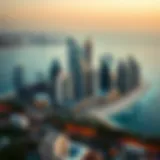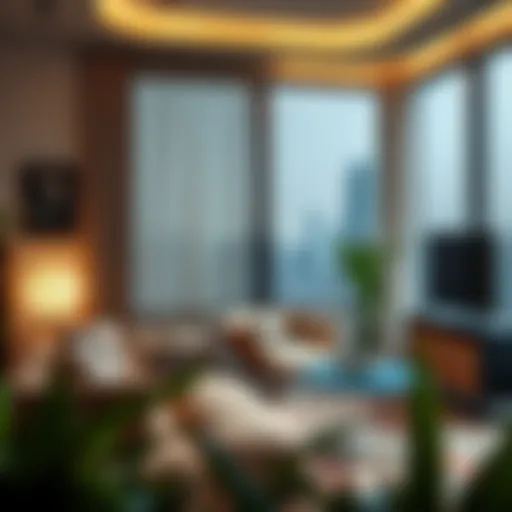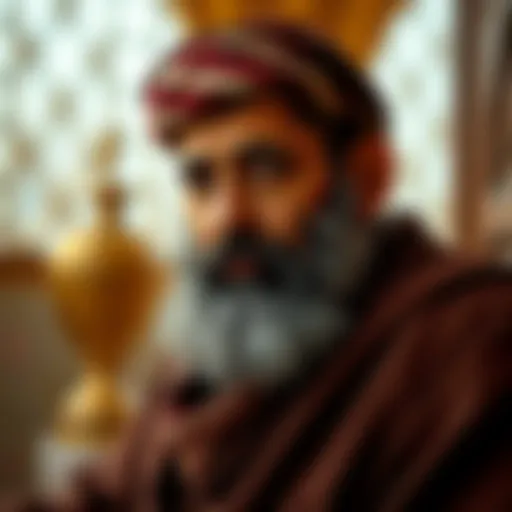Dubai's Skyline: The Interplay of Creek, Horizon, and Tower


Intro
Dubai’s skyline stands as a testament to modern architectural ambition, blending nature with human ingenuity. Characterized by piercing towers, a sprawling creek, and a horizon that dances between sun and sand, the city offers more than just stunning views. Instead, it presents a dynamic interplay between nature and urban development, shaping not just the physical landscape but also resonating through the real estate market. This nuanced exploration will unveil how the concepts of creek, horizon, and tower capture the essence of Dubai’s architectural identity and the investment landscape it creates.
Market Trends and Insights
Current Market Overview
The Dubai real estate market has seen a roller coaster of trends, particularly in the last few years. After the pandemic delay, there has been a palpable resurgence. Property prices in prime districts are climbing, especially those that boast proximity to the creek or stunning skyline views. Investment interest is spiking, fueled by foreign investors looking to capitalize on emerging opportunities.
Locations like Dubai Marina and Downtown Dubai are witnessing heightened activity. Many buyers are drawn to these areas not just for luxury living but also for the lifestyle that’s intricately woven into Dubai’s fabric. The vision of the horizon offers reassurance; it promises an ever-evolving cityscape.
Future Predictions and Opportunities
Looking ahead, Dubai's real estate market is anticipated to expand with developments tailored to cater to the increasing expatriate population. Projects on the rise emphasize sustainability, with an accent on greenery amidst the urban atmosphere. The intersection of creekside living and towering structures is likely to become even more pronounced. Investors may find emerging areas such as Dubai Creek Harbor as ripe for opportunity, merging scenic waters with innovative designs.
"The skyline isn’t just a collection of buildings; it’s a canvas of aspirations, a vision that reflects the pulse of the city."
Investing here isn’t merely about purchasing property; it represents becoming part of a thriving narrative, reflecting Dubai's ambitions.
Property Types and Listings
Luxury Apartments
For those inclined towards luxury, high-end apartments provide more than just living quarters. Buildings such as the Burj Khalifa or apartments along the Dubai Water Canal offer sweeping views of the horizon. The emphasis here is on exclusivity and state-of-the-art amenities, often paired with services that redefine comfortable living. Whether you seek a penthouse that overlooks the city or a cozy two-bedroom apartment, the options abound.
- Prime Locations:
- Burj Khalifa Residences
- Dubai Marina
- Downtown Dubai
These places serve as vantage points for residents, connecting them to the vibrancy of city life while providing a glimpse of the serene creek below.
Commercial Real Estate Options
The commercial sector is equally enticing, catering to businesses that aspire to establish themselves in a bustling economy. Office spaces and retail units are available with prime visibility, particularly those near transport links and tourist hotspots. Notable areas include:
- Business Bay: Known for its corporate offices, ideal for startups and established firms.
- Dubai Silicon Oasis: A hub for tech companies, promoting innovation and growth.
Investing in commercial real estate offers potential for consistent returns, especially in a city where the demand for space continues to rise.
In summary, as Dubai continues sculpting its future, the creek, horizon, and tower will remain pivotal in understanding its ever-evolving skyline. For informed investors, the fusion of these elements unlocks both an insight into Dubai’s identity and a pathway to lucrative opportunities.
Prelude to Dubai's Skyline
Dubai’s skyline is more than a mere canvas of towering glass and steel; it is a tapestry woven with the threads of history, innovation, and ambition. To fully grasp the essence of Dubai's architectural narrative, one cannot overlook the pivotal themes of the creek, horizon, and tower. Each element holds a distinct place, reflecting not only the city's past but also its aspirations for the future.
In this article, we'll peel back the layers of Dubai’s exciting skyline, focusing on how these three pillars interact and influence the city’s landscape. Imagine strolling down the vibrant streets, the shimmering waters of Dubai Creek to your left and the silhouette of majestic towers against a breathtaking horizon to your right. This visual dichotomy is emblematic of Dubai’s vision—an amalgamation of tradition and modernity, which is echoed throughout its architecture.
The Evolution of Dubai's Architectural Landscape
Dubai's architectural story is marked by rapid transformation. From humble beginnings as a modest fishing village, it has ascended to become a global hub of business and tourism. The early structures relied on local materials like coral and mud, seen in the Dubai Museum at Al Fahidi Fort, hinting at a time when practicality dictated design.
As oil wealth flowed in during the mid-20th century, so did the ambition to construct monumental projects. Noteworthy developments such as the Burj Al Arab and the Dubai Mall illustrate a shift toward increasingly extravagant designs. It’s like baubles in a window; the more they shine, the more they draw attention. The city has become a stage where architectural competition thrives, resulting in some of the most stunning buildings on earth.
The skyline now stands as a testament to human creativity, as if each tower tells a story of innovation and engineering prowess. This evolution is not just architectural; it encapsulates shifts in cultural identity and societal values, making the exploration of these three components all the more relevant as we look towards the future of urban dwelling.
Key Architectural Features
Specific architectural characteristics define Dubai's skyline. The interplay of light and shadow, the use of natural elements within structures, and the sustainable practices slowly embedding themselves among the concrete and glass reflect a multi-dimensional approach to urban design.
- Iconic Towers: Structures like the Burj Khalifa stand tall not just in height, but in what they represent. They are symbols of ambition, showcasing a striving towards impossible heights, both literally and metaphorically.
- Integrated Designs: Many buildings are crafted not just for visual impact but for interaction with the environment. The Dubai Frame, for instance, serves as a boundary between past and present, bridging cultural narratives through innovative architecture.
- Waterfront Concepts: The layout around Dubai Creek emphasizes connectivity and leisure. Parks and malls designed along the waterfront promote community interaction, ensuring that while the skyline soars, it remains grounded in the needs of its inhabitants.
Ultimately, the architectural features of Dubai's skyline reflect not just aesthetics but also the values of its rapidly growing populace. Investors and homeowners must appreciate how these features not only beautify the landscape but enhance property value, infusing the market with vibrancy and dynamism.
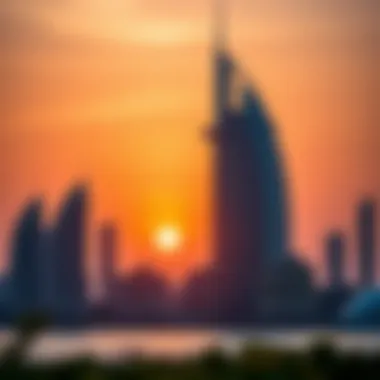

"Dubai’s skyline is a symbol of imagination in action, where every tower tells a tale of dreams made real."
As we delve deeper into the nuances of the creek, horizon, and tower, we will uncover how this interplay nurtures investment opportunities and dictates the future trajectory of Dubai's urban landscape.
Understanding Creek in the Urban Context
Dubai Creek serves as more than just a body of water; it is a significant artery that has shaped the city’s identity over the decades. From its historical roots as a fishing and pearling center, it has evolved into a thriving area that encapsulates both heritage and modernity. In the context of urban development, the creek's presence plays a crucial role in enhancing the aesthetic and functional attributes of the surrounding neighborhoods.
Historical Significance of Dubai Creek
Historically, Dubai Creek was the lifeblood of early merchants and fishermen. It was here that the emirate began its journey from a humble fishing village to a global economic hub. The creek's waters not only provided sustenance but also facilitated trade, allowing goods to flow in and out of the region. The area around the creek is dotted with historical sites, such as the Al Fahidi Fort, which now houses the Dubai Museum, serving as a testament to the city’s vibrant past.
In a way, the creek tells a story of resilience and transformation. As oil was discovered in the mid-20th century, the city's skyline started to morph, yet the creek remained a constant, grounding symbol of Dubai’s heritage. Cities tend to forget their roots, but Dubai has maintained a respect for its history, and the creek stands as a prominent landmark echoing this sentiment.
Current Developments Alongside the Creek
As the city has expanded, the developments alongside Dubai Creek reflect both a commitment to modernization and a desire to preserve the historical essence of the area. Today, you can see luxury resorts, waterfront promenades, and cultural institutions being constructed within a stone's throw from the historical sites. One notable project is Dubai Creek Tower, poised to be an architectural marvel that will redefine the city’s skyline while paying homage to the natural beauty of the creek.
Beyond the futuristic towers, the area is seeing a surge in residential investments. Developments such as Dubai Creek Harbour not only offer stunning views but also create community-centered environments. Real estate developers are being deliberate in incorporating green spaces and public amenities to ensure residents have a connection to nature, essential for a balanced urban lifestyle.
The spark of innovation is evident, with architects integrating smart technology and sustainable practices into their designs. As development continues, the aim remains clear: to facilitate a living and working environment that fosters growth while respecting the area’s cultural lineage.
"Dubai Creek is not just a historical site; it is a thriving epicenter of urban life, blending the old with the new."
In essence, understanding the creek's role in Dubai's urban context is critical for anyone interested in real estate investment or urban development. The juxtaposition of historical significance and modern convenience makes the areas surrounding the creek ripe for opportunities.
As Dubai races into the future, the creek stands as a reminder of where it all began, providing both a living and working ecosystem where the traditional and contemporary coexist.
The Philosophy of Horizon in Urban Design
Exploring the philosophy of horizon in urban design reveals more than just a visual element; it serves as a guiding principle that shapes the city's identity and influences livability. In a bustling metropolis like Dubai, where rapid development often competes with the natural environment, the horizon plays a crucial role in harmonizing the architectural landscape with its surroundings. This balance fosters a connection between residents and nature, underlining the importance of thoughtful integration in city planning.
Symbolic Interpretations of the Horizon
The horizon often represents a boundary, both literal and metaphorical. In Dubai, it symbolizes progress and aspiration. The view where land meets sky offers a sense of promise and opportunity. As one gazes across the skyline, they are inspired by projected futures shaped by innovation and growth. The horizon thus transcends mere aesthetics; it becomes a reflection of the city's transformation from a modest trading port to a global hub.
- Aesthetic Appeal: The interplay of light and shadow across the skyline during sunrise and sunset captivates residents and tourists alike. For developers, this presents an opportunity to design properties that maximize horizon views through strategic placement and architectural ingenuity.
- Cultural Significance: The horizon also has deep-seated cultural importance, resonating with themes of hope and ambition found throughout Dubai's history. Buildings are not just structures; they narrate stories, connect communities, and symbolize shared dreams.
"The horizon embodies both a promise of future achievements and a bridge to our past. It connects Dubai’s narrative to all who reside or visit here."
The Role of Horizon in Property Value
The horizon in Dubai doesn’t just serve as a pastoral backdrop; it significantly impacts real estate valuation. Properties with unobstructed views of the sea or skyline naturally command higher prices, creating a calm allure amid the urban hustle. Investors and homeowners need to understand how horizon-related features can enhance property desirability.
- Market Preferences: Studies indicate that potential buyers place a premium on properties that offer expansive views. According to real estate trends, homes overlooking Dubai Creek or facing the vast horizon fetch approximately 20% more in value.
- Future Developments: Property adjacent to the horizon offers unique investment potential. Many new developments are strategically designed to preserve these views, ensuring that their market value remains robust in the years to come.
The Tower: Icon of Modernity
In the remarkable tapestry of Dubai’s skyline, towers stand as prominent symbols of modernity and innovation, each constructed with a blend of advanced technology and artistic design. These structures do more than touch the sky; they embody the aspirations and dreams of a city perpetually in motion. Each tower tells a story of ambition, cultural significance, and the economic dynamism that defines Dubai. Their presence is critical, not only in shaping the city’s aesthetic but also in influencing its real estate market, making them integral to understanding the broader themes of creek, horizon, and tower.
Architectural Innovations in Tower Structures
The architectural landscape of Dubai is characterized by cutting-edge innovations that redefine what a tower can be. One might argue that the Burj Khalifa, the tallest building in the world, represents the pinnacle of such innovations. But it’s also essential to recognize other towers like the twisting Cactus Tower and the stunning Infinity Tower. These structures push boundaries and challenge conventional designs.
- Sustainable Design: Modern towers often incorporate sustainable features, like solar panels and rainwater harvesting systems. For example, the Diamond Tower includes materials sourced from recycled products, aiming to lessen its environmental footprint.
- Smart Technology Integration: Towers are increasingly becoming smart buildings outfitted with advanced technologies—think automated lighting systems that adjust based on occupancy or energy-efficient elevators that optimize energy consumption. The Coast Tower utilizes AI for energy management, resulting in substantial savings on operational costs.
- Flexible Spaces: Architectural firms, like Zaha Hadid Architects, are designing towers with flexible spaces that can be adapted for various uses. This versatility attracts a diverse range of tenants, from luxury apartments to offices, optimizing the utility of these towers.
Such architectural innovations not only enhance the functional aspect of buildings, but they also reflect the culture of innovation that resonates deeply within Dubai. This attitude attracts investors, making the skyline not just visually appealing but also a compelling canvas for real estate opportunities.
Impact of Iconic Towers on Real Estate Pricing
The presence of iconic towers significantly influences property values in their vicinity. A tower is not merely a structure; it has become a status symbol that adds allure to the neighborhoods around them. Such influence can be evident in various ways:
- Increased Demand: Locations near iconic towers often witness a spike in demand due to the perception of prestige associated with living or working close to such landmarks. Properties near Burj Al Arab frequently command higher prices because they offer unmatched views and accessibility.
- Investment Appeal: Investors are drawn to developments that feature iconic towers, envisioning a return on investment as property values appreciate over time. The presence of a tower can transform a neighborhood, making it more attractive for future development and leading to a surge in prices.
- Enhanced Amenities: Towers often come integrated with high-end amenities such as rooftop pools, fitness centers, and gourmet dining choices, which increase the desirability of surrounding real estate. For instance, the Address Marina features not just luxurious residential units but also retail spaces that cater to an affluent clientele, increasing the overall marketability of properties in that area.
As such, towers influence the real estate landscape in Dubai, making them more than mere architectural feats; they shape economic realities and lifestyle choices. In a city where aspirations soar as high as its towers, understanding the dynamics of these monumental structures is crucial for any investor or potential homeowner.
The Integration of Natural Elements
The incorporation of natural elements such as water, greenery, and landscape features into Dubai's urban fabric is an essential aspect of its architectural narrative. This integration not only enhances the city’s aesthetic appeal but also contributes to the overall well-being of its residents. With the desert as a backdrop, creating pockets of nature against the skyline of towers and expansive developments has been a crucial endeavor in Dubai’s urban planning strategy. It supports sustainability while making the city more livable. In this context, natural elements play a multi-faceted role, affecting everything from community health to property values.
Balancing Nature and Urban Development
Urban development is often seen as the antithesis of nature. In a bustling metropolis like Dubai, where towers scrape the sky and the heat of the desert is relentless, finding a balance between progress and preservation is paramount. Developers are increasingly recognizing the need to integrate more green spaces and natural features into their projects. For instance, the Creek waterfront area showcases a blend of commercial, residential, and recreational spaces, allowing nature to collaborate rather than compete with urbanization.
By prioritizing natural landscapes, planners can create environments that enhance social interactions and community bonding. Parks and lush green zones not only provide spaces for relaxation but also serve as venues for cultural events and activities, thereby enriching community life. This delicate balance fosters an atmosphere where the intriguing juxtaposition of the vibrant skyline meets the serenity of nature.
Green Spaces and Waterway Designs
The role of green spaces and waterways in urban design extends beyond visual appeal. They enhance environmental quality and support biodiversity. In Dubai, integrating parks, gardens, and waterfronts is increasingly seen as a necessity, not just an afterthought. For example, the Dubai Water Canal project has transformed an overlooked area into a lively hub filled with jogging paths, parklands, and waterfront dining options.
Investors should take note of how developments around green spaces are often more attractive to potential buyers. Properties near parks and waterways not only command higher prices but also promise better long-term returns. Access to these natural elements is akin to premium real estate, where buyers are inclined to pay a premium for a view that includes both towers and tranquil landscapes. Moreover, creating vibrant public spaces filled with native plants and waterways helps in cooling the urban heat, enhancing the city's livability.
In summary, the integration of natural elements into Dubai’s rapidly evolving skyline does more than beautify the city; it enriches the urban experience. As natural and manmade features converge, they foster a multisensory environment that appeals to investors, homeowners, and expatriates alike, driving both emotional and financial investment in Dubai's real estate market.
"In Dubai, the fusion of nature and architecture isn’t just an aesthetic choice; it’s a strategic imperative for sustainable growth."
For further reading on urban development and natural integration, you can explore resources from the World Economic Forum or visit Gulf News.
Investment Opportunities Surrounding the Creek
The Dubai Creek area is not just a beautiful site along the water. It's a beacon for investment opportunities that draw in both seasoned investors and first-time buyers alike. The potential for economic growth here is substantial, influenced by the area's rich history and ongoing development projects. The proximity to key locations such as the Dubai International Airport and significant commercial hubs adds another layer of appeal. Investors can find diverse opportunities ranging from residential apartments to luxury villas all alongside the scenic waters.
In this context, the creek serves as a lifeline for economic activities. As urban developments flourish, more and more amenities pop up around the area. Considerations include the infrastructure improvements, transport links, and nearby attractions which all contribute to the desirability of the neighborhood and its value in the market. Investing in properties surrounding the creek can provide excellent returns, particularly in emerging neighborhoods that are set to grow rapidly.
Emerging Neighborhoods and Economic Growth
The neighborhoods around Dubai Creek have seen a surge in interest from developers focusing on creating vibrant communities. New projects include mixed-use developments where one can find shopping, dining, and recreational spaces integrated with residential units. These emergent locales are strategically positioned to maximize the opportunities presented by the creek.
For instance, the area known as Dubai Creek Harbour is a prime example, aiming to become a premier lifestyle destination. It integrates green spaces and waterfront living, with affordable housing options appealing to various demographics, from young professionals to families. The growth of such neighborhoods is significant not merely for their immediate attractiveness but also in their long-term economic potential, fostering a lively community atmosphere.
“Investing in Dubai Creek's emerging neighborhoods is not just about buying real estate; it's about becoming part of a narrative filled with growth, innovation, and community.”
Case Studies of Successful Creekside Developments
In reviewing developments near Dubai Creek, several projects stand out for their success and community impact. One noteworthy example is the Creekside 18, which epitomizes the blending of residential comfort and stunning views of the waterway. This project attracted a mixture of local and international investors due to its strategic location and the upscale lifestyle it promises.
Another gem is the Dubai Creek Towers project. Set to redefine luxury living, it targets high-end clientele while ensuring a part of Dubai's historical narrative is preserved. The blend of innovative design and advanced technology makes this development particularly alluring despite its premium pricing.
Ultimately, the success of these developments is a testament to the increasing demand for waterfront properties and the potential for lucrative returns within the vicinity of the creek. Investors do well to keep an eye on these projects, as they not only represent outstanding investment opportunities but also play a pivotal role in shaping the future of Dubai’s landscape.
In summation, the investment possibilities surrounding the creek are as fluid as the waters themselves—constantly evolving and adapting to meet the needs of a growing population and ever-changing market dynamics.
Navigating the Market: Horizon as a Guide
Understanding the horizon's influence when investing in Dubai's real estate market can be like trying to read the stars without a map. The horizon doesn't merely decide what you see; it shapes your perception of value, potential, and desirability in property. In a bustling cityscape like Dubai, where every inch is hotly contested, leveraging the horizon can grant savvy investors an edge.
Understanding Market Trends Relative to Horizon
The horizon often dictates the charm and allure of properties. Areas with unobstructed views, especially of Dubai’s stunning skyline or natural landscapes, have higher demand. Investors must pay close attention to how these views are perceived over time, which can shift due to new buildings or shifting priorities in urban development.
- Visibility of Landmarks: Properties with a clear sightline to iconic landmarks such as the Burj Khalifa or the Palm Jumeirah often come with a premium.
- Emerging Neighborhoods: As neighborhoods develop, the horizon can change rather dramatically. Investors should look into upcoming areas where the sky isn't blocked yet but could become a target for new high-rises.
- Ethos of Outdoor Living: The importance of outdoor spaces has been rising. The horizon can play a role in how attractive these spaces are, prompting buyers to invest more in homes that offer scenic views.
Keeping an eye on these trends allows investors to anticipate changes and act accordingly.
Utilizing Horizon Views in Property Selection
Selecting a property isn't just about the building itself; it's also about what opens up beyond the windows. A property that screams luxury but has a view of a wall isn't as appealing as a modest condo overlooking the sea. Here’s how to arm yourself with horizon-savvy strategies:
- Prioritize Scenic Views: Always consider locations with expansive vistas. This factor not only enhances the quality of life but also acts as a powerful selling point when time comes to exit the investment.
- Evaluate Potential Developments: One mustn't ignore the evolving landscape. If land is vacant, it could harbor future developments that might obstruct views. In other words, don’t buy blind; know what’s on the drawing board.
- Go for the Gold: Properties in prime spots with great horizon views often appreciate faster. A good vista can make the difference between a flat sale and a profitable one down the line.
"The view from a property is just as crucial as its foundation. Don't underestimate the power of a skyline in driving value."
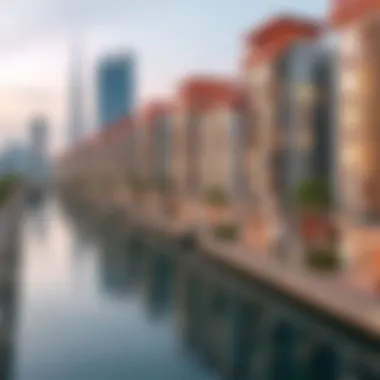

By reconnecting horizon views with investor intentions and decisions, buyers can better navigate Dubai’s continually shifting real estate waters, ensuring they’re making informed, advantageous choices.
The Future of Tower Development in Dubai
As Dubai continues to evolve into a global beacon of architectural innovation, the future of tower development holds significant promise as it reflects the city’s aspirations and demographics. With a skyline that is constantly being reshaped, it's crucial to understand how these towering giants will adapt to meet the complexities of urban life.
A progressive approach to tower development not only gauges current market demands but also anticipates future trends. Real estate developers are increasingly wrestling with the duality of luxury and functionality, striving to create not just buildings but fully integrated living experiences that sustain the city's frenetic pace. The upcoming towers aim to incorporate state-of-the-art technology, aesthetic elegance, and purpose-driven spaces that cater to both residents and visitors.
Next-Generation Towers and Their Features
The aspiration for next-generation towers signifies more than just height; it embodies a shift in how architecture interacts with its environment. These upcoming projects are focused on several key features:
- Smart Technology Integration: New towers are set to incorporate smart home technologies, allowing residents to control their surroundings with just a few taps on their smartphones. This tech-driven approach caters to the growing demand for convenience and security.
- Mixed-Use Spaces: There’s a trend towards integrating residential, commercial, and recreational spaces within the same tower. This concept allows for a more vibrant community experience while minimizing the need for extensive commuting.
- Flexible Floor Plans: Given the changing lifestyles, developers are now creating flexible living spaces that can adapt to the diverse needs of families and individuals alike.
These features represent a significant shift in the approach toward urban living, prompting a rethink of what it means to occupy space in a bustling metropolis.
Sustainability in Tower Architecture
Sustainability emerges as a cornerstone of design philosophy for the future of tower development in Dubai. As the city faces ongoing challenges from climate change and resource management, it becomes imperative to integrate sustainable practices into architectural frameworks.
Features that underscore this commitment include:
- Energy-Efficient Systems: Many new towers will utilize solar panels, energy-efficient windows, and HVAC systems that reduce overall utility consumption.
- Green Roofs and Vertical Gardens: These elements not only enhance aesthetic appeal but also improve air quality and provide insulation, demonstrating a commitment to ecological responsibility.
- Water Conservation Technologies: The incorporation of rainwater harvesting systems signifies a pragmatic approach to resource management.
"Architecture is not just about creating spaces; it’s about connecting with the environment in a symbiotic relationship."
Overall, the future trajectory of tower development in Dubai encapsulates an exciting fusion of technology, community needs, and environmental consciousness. Investors and homeowners should pay close attention to these evolving trends, as they promise not only to enhance the skyline but also to enrich the urban lifestyle.
Assessing the Impact of Creek, Horizon, and Tower
The intricate relationship between creek, horizon, and tower forms a cornerstone in understanding Dubai's urban narrative. These elements do not merely coexist; they interact to create a dynamic milieu that defines not just the skyline but also the way communities engage with their environment. As urban spaces continue to evolve, assessing the impact of these elements becomes vital for stakeholders, from government planners to individual investors.
Influence on Community Development
The synergy between creek, horizon, and tower plays a significant role in shaping community development. The waterfronts of Dubai Creek, for instance, invite leisure activities and promote social interaction among residents. As communities thrive around this natural resource, they cultivate a sense of belonging and identity.
- Urban Connectivity: The creek serves as a natural corridor that links various neighborhoods. Increased accessibility encourages people to explore and engage with their surroundings, fostering vibrant communities.
- Cultural Spaces: Design features such as parks and promenade areas alongside the creek offer recreational opportunities. This adds cultural depth, enabling art installations and festivals that enhance community ties.
- Population Growth: As residential towers rise near the creek, more residents are attracted to the area. This, in turn, places pressure on local amenities, necessitating strategic planning to manage growth effectively.
Overall, when communities are designed with attention to these elements, residents experience a higher quality of life. It creates a ripple effect that touches aspects like health, social cohesion, and even safety.
Long-term Economic Implications
From an economic standpoint, the interplay of creek, horizon, and tower presents numerous implications that are vital for long-term urban sustainability. Each element contributes to the overall economic fabric of the city, affecting everything from property values to commercial viability.
- Property Demand: Buildings with views of the creek or expansive horizon typically command higher prices. This creates an incentive for developers to invest in projects that enhance visibility and accessibility, leading to increased land values.
- Tourism Growth: Iconic towers are not just structures; they symbolize the city itself. Such landmarks attract tourists, which in turn supports local businesses, thereby boosting the economy.
- Investment Opportunities: As areas around the creek develop, they become hotspots for both residential and commercial investments. Numerous case studies have shown that early investments in these emerging locales can yield significant returns as the market grows.
Investing in properties that leverage the unique characteristics of creek, horizon, and tower can drive not only personal wealth but also contribute to the overall economic development of Dubai.
Finale: The Convergence of Creek, Horizon, and Tower
The interplay between the creek, horizon, and towering skyscrapers of Dubai paints a unique picture of urban life that invites both admiration and investment. Each element serves as a crucial thread in the fabric of the city’s architectural narrative, revealing how tradition and modernity harmoniously coexist.
The creek stands as a reminder of Dubai’s rich heritage and its growth from a humble fishing village to a global city. It not only enhances the aesthetic appeal of the skyline but also offers various economic opportunities through tourism and waterfront living. The horizon, on the other hand, embodies potential and progress. It influences property values while providing breathtaking views that attract homeowners and investors alike. Finally, the tower symbolizes ambition and innovation, showcasing the heights of modern engineering and design. This convergence can drive community development while influencing economic trends.
Summarizing Key Insights
- Integration of Tradition and Progress: The creek reminds us of Dubai’s rich history, while the horizon and towers signify aspirations for the future.
- Investment Opportunities: Each element contributes to a multifaceted real estate market. Investors can find lucrative options from waterfront properties along the creek to high-rise apartments that offer stunning skyline views.
- Community Development: The inclusion of natural landscapes and towering structures fosters a sense of community, supporting various lifestyles.
The combination of these urban elements shapes not just the physical landscape, but also the cultural and economic dynamics of Dubai.
Future Prospects for Dubai's Real Estate Landscape
The future of Dubai's real estate appears bright, with several trends shaping its trajectory. As urbanization continues, the demand for properties near the creek is expected to rise. The development of leisure and retail spaces along the waterfront will further enhance its appeal.
Moreover, as sustainability takes center stage, architects are focusing on eco-friendly designs for new towers, integrating green technologies and open spaces that respect the environment.
The convergence of creek, horizon, and tower is not just about aesthetics; it is a blueprint for urban prosperity.
Additionally, the horizon will remain a guiding principle for developers. Properties with unobstructed views will hold value, pushing up prices as the city evolves. Potential buyers will increasingly look for homes that marry scenic vistas with accessibility to urban conveniences.
Through thoughtful planning and strategic investments, Dubai's skyline will continue to captivate not only the eye but also the heart of those seeking vibrant urban living.


